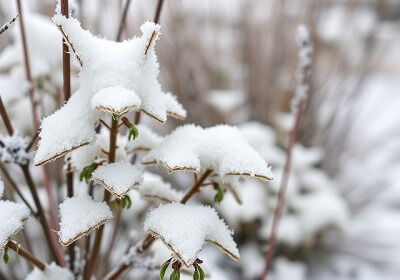 Winter is a challenging season for plants, as frost and snow can cause severe damage. By winterizing your garden, you can shield your plants from these harsh elements and help them survive until spring. Here are practical steps to protect your garden and ensure your plants remain healthy throughout the colder months.
Winter is a challenging season for plants, as frost and snow can cause severe damage. By winterizing your garden, you can shield your plants from these harsh elements and help them survive until spring. Here are practical steps to protect your garden and ensure your plants remain healthy throughout the colder months.
1. Choose the Right Mulch for Insulation
Mulch is one of the best defenses against frost, as it helps retain soil warmth and protects plant roots from temperature fluctuations.
- Apply a thick layer of mulch around the base of trees, shrubs, and perennials.
- Use natural materials like straw, wood chips, or shredded leaves for added insulation.
- Aim for a layer around 2-4 inches deep, and avoid piling mulch directly against plant stems to prevent rot.
2. Use Frost Cloths and Covers
Frost cloths, row covers, and even simple burlap are effective ways to protect plants from frost and snow.
- Drape frost cloths or fabric over sensitive plants during cold snaps, securing the edges to the ground to trap heat.
- Use stakes or frames to keep covers from directly touching delicate foliage.
- Remove covers during the day to allow sunlight and fresh air to reach the plants, re-covering them in the evening.
3. Create Windbreaks for Extra Protection
Cold winds can increase frost damage, so setting up a windbreak can provide additional shelter for your plants.
- Use natural windbreaks like evergreen shrubs or hedges to protect tender plants.
- Consider temporary barriers, such as wooden stakes or burlap screens, to block the wind for smaller plants.
- Place potted plants near walls, fences, or hedges for added warmth and wind protection.
4. Wrap Young or Tender Trees and Shrubs
Newly planted trees and young shrubs are particularly vulnerable to cold weather, so adding protection can prevent damage.
- Wrap the trunks of young trees in burlap or tree wrap to prevent frost cracks.
- Insulate the base of each shrub with a layer of mulch or straw to protect the root zone.
- For extra-delicate plants, wrap the entire shrub or tree in burlap, leaving some airflow to prevent moisture buildup.
5. Water Thoroughly Before a Freeze
Moist soil retains heat better than dry soil, which helps moderate temperature swings around plant roots.
- Water plants well before an expected freeze, especially evergreens, as they lose moisture through their leaves.
- Be careful not to overwater, as waterlogged roots can lead to rot.
- Avoid watering when the ground is already frozen, as the roots won’t absorb the moisture.
6. Move Container Plants Indoors or Closer to Shelter
Plants in containers are more susceptible to frost because the roots are above ground, making them vulnerable to cold.
- Move potted plants indoors or into a sheltered area like a garage or shed.
- Group pots together near a wall or in a protected corner to create a microclimate.
- For larger containers, insulate with bubble wrap, burlap, or blankets to keep roots warm.
7. Use Cold Frames or Cloches for Sensitive Plants
Cold frames and cloches are ideal for protecting small plants or seedlings that need extra warmth.
- Set up cold frames over vegetable beds, herbs, or young plants to create a mini-greenhouse effect.
- Place cloches (glass or plastic covers) over individual plants to trap heat and shield them from frost.
- Open cold frames and cloches during sunny days to allow airflow, closing them at night for added insulation.
8. Prune Wisely Before Winter
Winter pruning can strengthen your plants and minimize winter damage, but timing and technique are essential.
- Trim back weak or diseased branches on shrubs and trees to reduce wind damage.
- Avoid pruning most plants heavily in late fall, as new growth can be more vulnerable to frost.
- Prune only after the plants have gone dormant, as this minimizes stress.
9. Avoid Fertilizing Late in the Season
Late-season fertilization can encourage tender new growth that is especially susceptible to frost.
- Stop fertilizing perennials and shrubs in late summer to allow plants to harden off before winter.
- Reserve fertilization for early spring when new growth will benefit from nutrients.
- For evergreens, light fertilization in early fall may be helpful, but avoid heavy applications.
10. Keep Snow and Ice at Bay
Snow can offer natural insulation, but ice buildup is often damaging to plants.
- Lightly brush snow off shrubs and trees to prevent branches from snapping under heavy loads.
- Avoid using salt or chemical de-icers near plants, as they can damage roots and foliage.
- Consider using sand, sawdust, or pet-safe de-icers if you need traction around garden paths.
By following these winterizing techniques, you can help your garden survive the winter and thrive in the spring. Protecting your plants from frost and snow is not only essential for their health but also an investment in a vibrant garden season to come.






